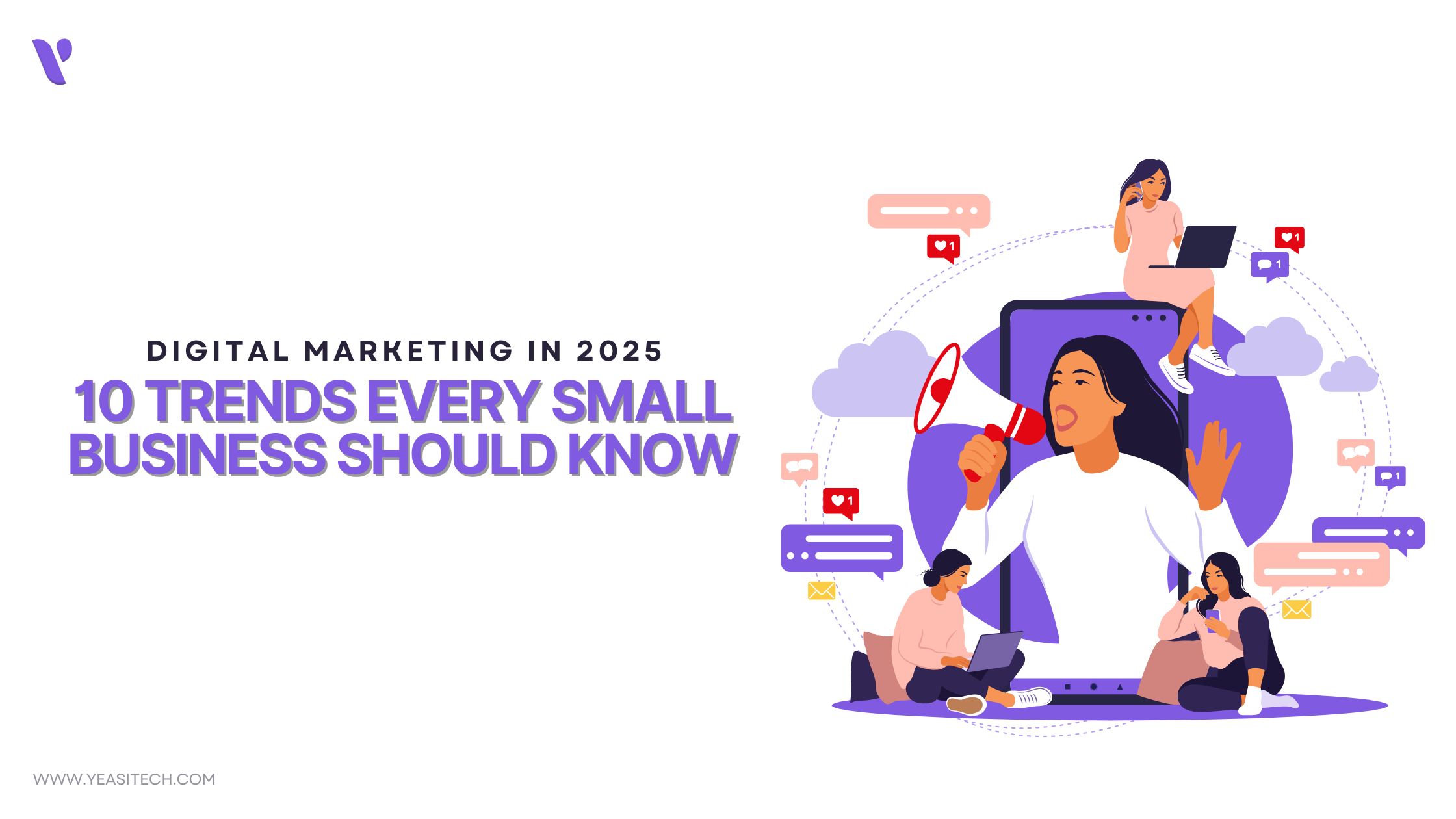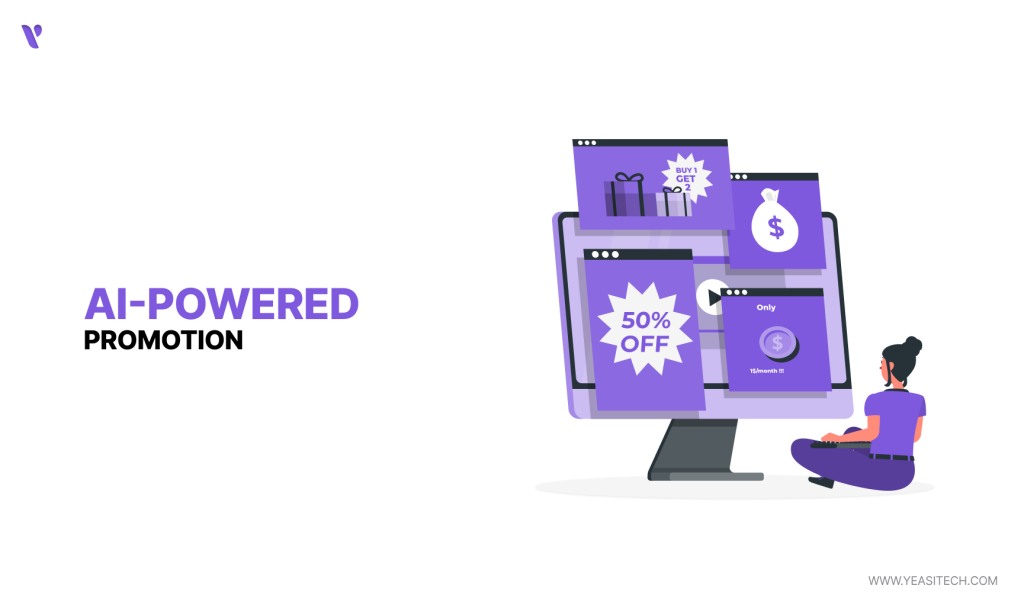Digital Marketing in 2025: 8 Trends Every Small Business Should Know

Small businesses must deal with both new opportunities and challenges as a result of the rapid evolution of digital marketing. Small businesses must be one step ahead of the competition in order to succeed. Businesses that embrace these trends will see rapid expansion as AI, video content, customization, and a more connected global audience all increase.
The ten important digital marketing trends for small businesses in 2025 are highlighted in this blog supported by data, statistics, case studies, and real-world examples.
Short-form videos platforms like YouTube Shorts, TikTok, and Instagram Reels are gaining popularity among users. Wyzowl’s 2024 video marketing statistics indicate that after seeing a short video, customers are 84% more likely to purchase a product.

Small businesses should create attractive videos to capture the interest of potential customers and encourage recall of the brand.
“The best way to predict the future is to create it.” – Peter Drucker
Cult.fit, a fitness app, frequently posts short training videos on YouTube Shorts and Instagram. They expand user engagement by 15% as a result of these videos, which draw more users and promote more app downloads.
Impact and Outcomes:
Smart devices like Google Home and Amazon Alexa are driving the growing popularity of voice search. Around the globe, 2020, 4.2 billion digital voice assistants were being used, according to Statista’s data. 2025 is expected to quadruple and reach 8.4 billion, surpassing the world population.

Why it is Important
To draw in potential customers who use voice search, small companies should make improvements to their websites. This involves using structured data, optimizing for local inquiries, and using natural language.
Indian home services company UrbanClap upgraded its voice search engine, concentrating on local searches such as “best electrician near me.” Consequently, they saw a 20% increase in organic voice search traffic, particularly from mobile devices.
Impact and Outcomes:
Digital marketing is being revolutionized by Artificial Intelligence with its provision of data insights, automation, and customized consumer experiences. Chatbots, customer segmentation, content creation, and predictive analytics are used for it.

Why it is Important
AI may simplify marketing for small businesses and improve customer relationships by providing a more customized approach. The AI marketing industry is expected to grow to a value of $48.8 billion by 2028, according to a Statista study (Or: Statista projects that the AI marketing industry will reach a value of $48.8 billion by 2028.
Consumers have a better experience when they use AI chatbots employed by Lenskart, one of India’s largest eyeglass retailers, to help them choose frames. This chatbot handles 30% sales tasks and reduces customer service tasks by 60%.
Impact and Outcomes:
Small businesses can still effectively reach their target audiences at a fair price through influencer marketing, particularly with micro-influencers. A 2024 HubSpot research found that for every $1 spent on influencer marketing, businesses earn $5.20.

Why it is Important
Influencers, especially local or micro-influencers, work with small businesses to establish trust and genuine connections with their audience.
“People influence people. Nothing influences people more than a recommendation from a trusted friend.” – Mark Zuckerberg
Instagram was used by micro-influencers to promote toxin-free products for the Indian personal care company Mamaearth. As a result of the excitement this campaign created, sales rose by 25% and internet traffic rose by 40%.
Impact and Outcomes:
Social networking sites are increasingly used for social commerce, or making direct purchases. According to a 2024 Statista estimate, social commerce is predicted to generate $1.2 trillion in global sales by 2025.

Why it is Important
Social commerce reduces the time it takes for customers to identify and purchase products, which benefits small businesses by increasing revenues.
Customers may easily purchase items from Indian fashion business Bewakoof without ever leaving the app because to its direct Instagram Shop sales. In just six months, this strategy raised company revenue by 15%.
Impact and Outcomes:
Customers are expecting more and more customized services, and businesses who don’t provide them run the risk of losing business. 80% of consumers are more likely to buy from businesses that offer customized customer care, per a 2023 Epsilon survey.

Why it is Important
Small businesses may better target their marketing efforts, whether they be through social media advertisements or email campaigns, by using data analytics and knowing client preferences.
Artificial intelligence (AI) is used by Flipkart, the biggest online retailer in India, to recommend products based on user preferences. The average amount spent on purchases has increased by 30% and consumer loyalty by 25% as a result of this method.
Impact and Outcomes:
In order to engage audiences and generate organic traffic, content marketing is still essential. But in 2025, the emphasis will be on producing stories that engage customers more deeply. Brands are more likely to connect with their audience if they tell compelling tales.

Why it is Important
Storytelling may help small businesses build enduring relationships with their customers, evoke strong feelings in them, and make their brand more relevant.
Marketing is no longer about the stuff you make but about the stories you tell.” – Seth Godin
Mumbai’s Dabbawalas, who are popular for delivering lunchboxes quickly, collaborated with digital marketers to share their tale of tenacity and hard work. Their service memberships increased by 20% as a result of this very visible marketing effort.
Impact and Outcomes:
Infographics, polls, and quizzes are examples of interactive content that keeps visitors interested for longer and provides valuable insights about customer preferences. A 2023 research by Demand Gen found that when compared to standard content, interactive content doubles conversions.

Why it is Important
Startups may gather information to enhance their marketing tactics and create more engaging user experiences with interactive content.
Nykaa, one of India’s leading cosmetic retailers, introduced interactive tests to help clients choose the best skincare products. Customers’ time on the website increased by 25% as a consequence of this effort, and revenues increased by 15%.
Impact and Outcomes:
In 2025, as digital marketing expands, small businesses need to be adaptable. Stronger privacy safeguards and AI-powered customization are two new trends that will help companies increase sales, foster customer relationships, and gain confidence.
By keeping up with new trends and using the latest digital marketing methods, small businesses can discover new ways to grow and succeed in the long run.
Your business can be different from others if you use these new ideas in your marketing. For simple tips and helpful advice for small businesses, visit YeasiTech’s blog to learn how to use these ideas.
AI-powered marketing, voice search optimization, influencer marketing, short-form videos, extensive customization, social commerce, sustainability marketing, privacy-focused tactics, narrative content, and interactive content are the main trends in digital marketing.
Small businesses benefit from AI-powered marketing because it simplifies processes, analyzes data, builds customized customer experiences, and improves advertising efforts. This results in increased conversion rates and improved efficiency.
Influencer marketing, especially with micro-influencers, helps small businesses reach specific audiences, build trust in their brand, and increase sales, all at a lower cost.
In 2025, customization will be important as customers need customized experiences. Campaign customization can increase conversion rates, build brand loyalty, and promote consumer engagement.
Short-form videos on platforms like Instagram Reels and TikTok grab attention fast, increase brand visibility, and help small businesses get more engagement and sales.
Small businesses must prioritize data protection as privacy laws become stricter in order to gain the trust of their customers, stay out of trouble with the law, and be transparent about how they handle client information.
YeasiTech is a trusted IT service partner with 8+ years of experience, empowering 250+ businesses with scalable web, mobile and AI solutions.
Explore related topics to broaden your understanding and gain actionable insights that can transform your strategies.